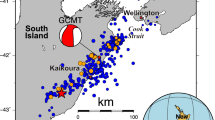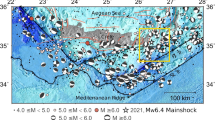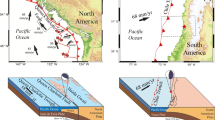Abstract
We constrain the source of the 27 November 1945 tsunami in the Makran Subduction Zone (MSZ) using available tsunami waveforms recorded on tide gauges at Mumbai (India) and Karachi (Pakistan), and that inferred at Port Victoria (Seychelles), and coseismic deformation data along the Makran coast. Spectral analysis of the tsunami waveforms shows that the tsunami governing period was 40–50 min at Karachi whereas it was around 22 min at Mumbai. The inferred tsunami waveform at Port Victoria also indicated a period of around 21 min for the tsunami. Tsunami numerical simulations from the previously proposed source models failed in reproducing the observed tsunami waveforms and coseismic deformation data. Sensitivity analysis showed that the source fault needs to be extended offshore into deep water in order to reproduce the first 22-min signal at Mumbai. Based on the inversion of the observed tsunami waveforms, we propose a four-segment fault with varying slip amounts as the final source. This source includes a slip of 4.3 m onshore near Ormara (Pakistan) and a slip of 10 m offshore at water depth of around 3,000 m. The total fault length is 220 km, and the average slip is 6.1 m. This source, first, reproduces fairly well the observed tide gauge records at Mumbai and Karachi, second, produces ~1 m of uplift at Ormara and ~1 m of subsidence at Pasni, and third, gives a moment magnitude of 8.3 for the earthquake, which is in the acceptable range of seismic data. The computed 1 m uplift at Ormara is in the uplift range of 1–3 m reported in the literature. As the tide gauge stations were located in the far field, our proposed source explains mainly the tectonic source of the tsunami.









Similar content being viewed by others
References
Beer, A., and Stagg, J.M. (1946), Seismic sea-wave of November 27, 1945, Nature 158, 63.
Bell, C., Vassie, J.M., and Woodworth, P.L. (2000), POL/PSMSL Tidal Analysis Software Kit 2000 (TASK-2000), Permanent Service for Mean Sea Level. CCMS Proudman Oceanographic Laboratory, UK, 22p.
Borrero, J. C., and Greer, S. D. (2013), Comparison of the 2010 Chile and 2011 Japan tsunamis in the far field, Pure Appl. Geophys. 170 (6–8), 1249–1274.
Byrne, D.E., Sykes, L.R., and Davis, D.M. (1992), Great thrust earthquakes and aseismic slip along the plate boundary of the Makran subduction zone, J. Geophys. Res. 97 (B1), 449–478.
Donato, S. V., Reinhardt, E. G., Boyce, J. I., Pilarczyk, J. E., and Jupp, B. P. (2009), Particle-size distribution of inferred tsunami deposits in Sur Lagoon, Sultanate of Oman, Mar. Geol. 257(1), 54–64.
Duda, S. J. (1965), Secular seismic energy release in the circum-Pacific belt, Tectonophysics 2(5), 409–452.
Fujii, Y., Satake, K., Sakai. S, Shinohara, M., and Kanazawa, T. (2011). Tsunami source of the 2011 off the Pacific coast of Tohoku Earthquake, Earth Planets Space 63, 815–820.
Fritz, H.M, Blount, C.D., Albusaidi, F.B., Al-harthy, A.H.M. (2010). Cyclone Gonu Storm Surge in Oman, Estuar. Coast. Shelf Sci., 86(1), 102–106.
Gutenberg, B., and Richter, C.F. (1954), Seismicity of the earth and associated phenomena, 2nd edition, Princeton University Press.
Heck, N.H. (1947), List of seismic sea waves, Bull. Seismol. Soc. Am. 37(4), 269–286.
Heidarzadeh, M., Pirooz, M.D., Zaker, N.H., Yalciner, A.C., Mokhtari, M., and Esmaeily, A. (2008a), Historical tsunami in the Makran subduction zone off the southern coasts of Iran and Pakistan and results of numerical modeling, Ocean Eng. 35(8 & 9), 774–786.
Heidarzadeh, M., Pirooz, M.D., Zaker, N.H., Synolakis, C.E. (2008b), Evaluating tsunami hazard in the northwestern Indian Ocean. Pure Appl. Geophys. 165 (11–12), 2045–2058.
Heidarzadeh, M., Pirooz, M.D., Zaker, N.H., and Yalciner, A.C. (2009a), Preliminary estimation of the tsunami hazards associated with the Makran subduction zone at the northwestern Indian Ocean, Nat. Hazards 48(2), 229–243.
Heidarzadeh, M., Pirooz, M.D., and Zaker, N. H. (2009b), Modeling the near-field effects of the worst-case tsunami in the Makran subduction zone, Ocean Eng. 36(5), 368–376.
Heidarzadeh, M., and Satake, K. (2013a), The 21 May 2003 Tsunami in the Western Mediterranean Sea: Statistical and Wavelet Analyses, Pure Appl. Geophys. 170 (9–10), 1449–1462.
Heidarzadeh, M., and Satake, K. (2013b), Waveform and Spectral Analyses of the 2011 Japan Tsunami Records on Tide Gauge and DART Stations Across the Pacific Ocean, Pure Appl. Geophys. 170 (6–8), 1275–1293.
Heidarzadeh, M., and Kijko, A. (2011), A probabilistic tsunami hazard assessment for the Makran subduction zone at the northwestern Indian Ocean, Nat. Hazards 56(3), 577–593.
Heidarzadeh, M., and Satake, K. (2014), Possible sources of the tsunami observed in the northwestern Indian Ocean following the 2013 September 24 Mw 7.7 Pakistan inland earthquake, Geophys. J. Int. 199 (2), 752–766.
Hoffmann, G., Rupprechter, N., Albalushi, N., Grutzner, C., Reicherter, K. (2013), The impact of the 1945 Makran tsunami along the coastlines of the Arabian Sea (Northern Indian Ocean) – a review, Z. Geomorphologie 57(4), 257–277.
IOC, IHO, and BODC (2003), Centenary edition of the GEBCO digital atlas, published on CD-ROM on behalf of the Intergovernmental Oceanographic Commission and the International Hydrographic Organization as part of the general bathymetric chart of the oceans, British Oceanographic Data Centre, Liverpool.
Jaiswal, R. K., Singh, A. P., and Rastogi, B. K. (2009), Simulation of the Arabian Sea tsunami propagation generated due to 1945 Makran earthquake and its effect on western parts of Gujarat (India), Nat. Hazards 48(2), 245–258.
Kreyszig, E. (2010), Advanced engineering mathematics, 10th edition, Wiley, New York, USA.
Mathworks (2014), MATLAB user manual, MathWorks Inc., MA, USA, 282 p.
Mokhtari, M. (2014), The role of splay faulting in increasing the devastation effect of tsunami hazard in Makran, Oman Sea, Arab. J. Geosci., pp 8. doi:10.1007/s12517-014-1375-1
Nature (1945), Earthquake in the Arabian Sea, Nature 156, 712–713.
Neetu, S., Suresh, I., Shankar, R., Nagarajan, B., Sharma, R., Shenoi, S. S. C., Unnikrishnan, A.S., and Sundar, D. (2011), Trapped waves of the 27 November 1945 Makran tsunami: observations and numerical modeling, Nat. Hazards 59(3), 1609–1618.
Okada, Y. (1985), Surface deformation due to shear and tensile faults in a half space, Bull. Seismol. Soc. Am. 75(4), 1135–1154.
Okal, E.A., Fritz, H.M., Raad, P.E., Synolakis, C.E., Al-shijbi, Y., Al-saifi, M. (2006). Field survey of the 2004 Indonesian Tsunami in Oman, Earthq. Spectra 22(S3), S203–S218.
Page, W. D., Alt, J. N., Cluff, L. S., and Plafker, G. (1979), Evidence for the recurrence of large-magnitude earthquakes along the Makran coast of Iran and Pakistan, Tectonophysics 52(1), 533–547.
Pendse, C. G. (1946), The Mekran earthquake of the 28th November 1945, India Meteorol. Depart. Sci. Notes 10(125), 141–145.
Pilarczyk, J. E., and Reinhardt, E. G. (2012), Testing foraminiferal taphonomy as a tsunami indicator in a shallow arid system lagoon: Sur, Sultanate of Oman, Mar. Geol. 295, 128–136.
Quittmeyer, R. C., and Jacob, K. H. (1979), Historical and modern seismicity of Pakistan, Afghanistan, northwestern India, and southeastern Iran, Bull. Seismol. Soc. Am. 69(3), 773–823.
Rabinovich, A.B. (1997), Spectral analysis of tsunami waves: Separation of source and topography effects, J. Geophys. Res. 102(12), 663–676.
Rabinovich, A.B., and Thomson, R.E. (2007), The 26 December 2004 Sumatra tsunami: analysis of tide gauge data from the World Ocean Part 1. Indian Ocean and South Africa, Pure Appl. Geophys. 164, 261–308.
Rajendran, C. P., Rajendran, K., Shah-hosseini, M., Beni, A. N., Nautiyal, C. M., and Andrews, R. (2013), The hazard potential of the western segment of the Makran subduction zone, northern Arabian Sea, Nat. Hazards 65(1), 219–239.
Richter, C. F. (1958), Elementary Seismology, W.H. Freeman, San Francisco.
Satake, K. (1987), Inversion of tsunami waveforms for the estimation of a fault heterogeneity: Method and numerical experiments, J. Phys. Earth, 35(3), 241–254.
Satake, K., Fujii, Y., Harada, T., Namegaya, Y. (2013), Time and space distribution of coseismic slip of the 2011 Tohoku earthquake as inferred from tsunami waveform data, Bull. Seismol. Soc. Am. 103(2B), 1473–1492.
Satake, K., and Tanioka, Y. (2003), The July 1998 Papua New Guinea earthquake: Mechanism and quantification of unusual tsunami generation, Pure Appl. Geophys. 160(10–11), 2087–2118.
Shah-hosseini, M., Morhange, C., Naderi Beni, A., Marriner, N., Lahijani, H., Hamzeh, M., and Sabatier, F. (2011), Coastal boulders as evidence for high-energy waves on the Iranian coast of Makran, Marine Geology 290(1), 17–28.
Smith, G. L., Mcneill, L. C., Wang, K., He, J., and Henstock, T. J. (2013), Thermal structure and megathrust seismogenic potential of the Makran subduction zone, Geophys. Res. Lett. 40(8), 1528–1533.
Takahashi, T., Takahashi, T., Shuto, n., Imamura, F., and Ortiz, M. (1995), Source models for the 1993 Hokkaido Nansei-Oki earthquake tsunami, Pure Appl. Geophys. 144(3–4), 747–767.
Tanioka, Y. and Satake, K. (1996), Tsunami generation by horizontal displacement of ocean bottom, Geophys. Res. Lett. 23, 861–864.
Tinti, S., Armigliato, A., Bortolucci, E., and Piatanesi, A. (1999), Identification of the source fault of the 1908 Messina earthquake through tsunami modelling. Is it a possible task?, Phys. Chem. Earth 24(5), 417–421.
Torrence, C. and Compo, G. (1998), A practical guide to wavelet analysis, Bull. Am. Met. Soc., 79, 61–78.
Welch, P.D. (1967), The Use of Fast Fourier Transform for the Estimation of Power Spectra: A Method Based on Time Averaging Over Short, Modified Periodograms, IEEE Trans. Audio Electroacoustics AU-15, 70–73.
Yalciner, A.C., Pelinovsky, E., Talipova, T., Kurkin, A., Kozelkov, A., and Zaitsev, A. (2004), Tsunamis in the Black Sea: comparison of the historical, instrumental, and numerical data. J. Geophys. Res. 109 (12), 2003–2113.
Acknowledgments
The tide gauge records of the Makran tsunami of November 1945 at Karachi and Mumbai were first retrieved by Neetu et al. (2011) and were digitized here for this study. We thank two anonymous reviewers for their constructive comments. We are grateful to Dr. Hermann M. Fritz (the editor) and Dr. Takeo Ishibe for their critical reviews of the manuscript. This study was supported by the Japan Society for the Promotion of Science (JSPS).
Author information
Authors and Affiliations
Corresponding author
Rights and permissions
About this article
Cite this article
Heidarzadeh, M., Satake, K. New Insights into the Source of the Makran Tsunami of 27 November 1945 from Tsunami Waveforms and Coastal Deformation Data. Pure Appl. Geophys. 172, 621–640 (2015). https://doi.org/10.1007/s00024-014-0948-y
Received:
Revised:
Accepted:
Published:
Issue Date:
DOI: https://doi.org/10.1007/s00024-014-0948-y




